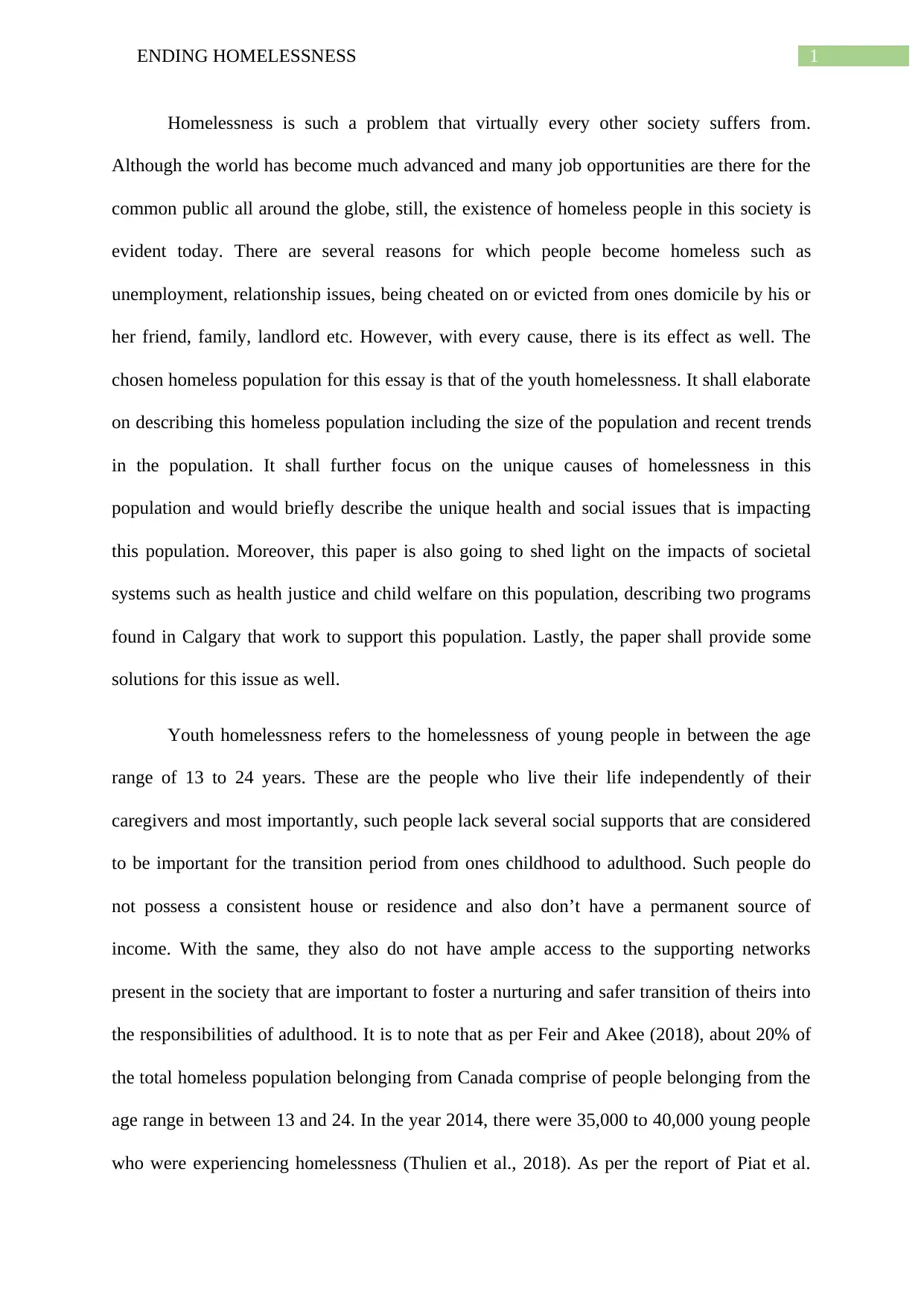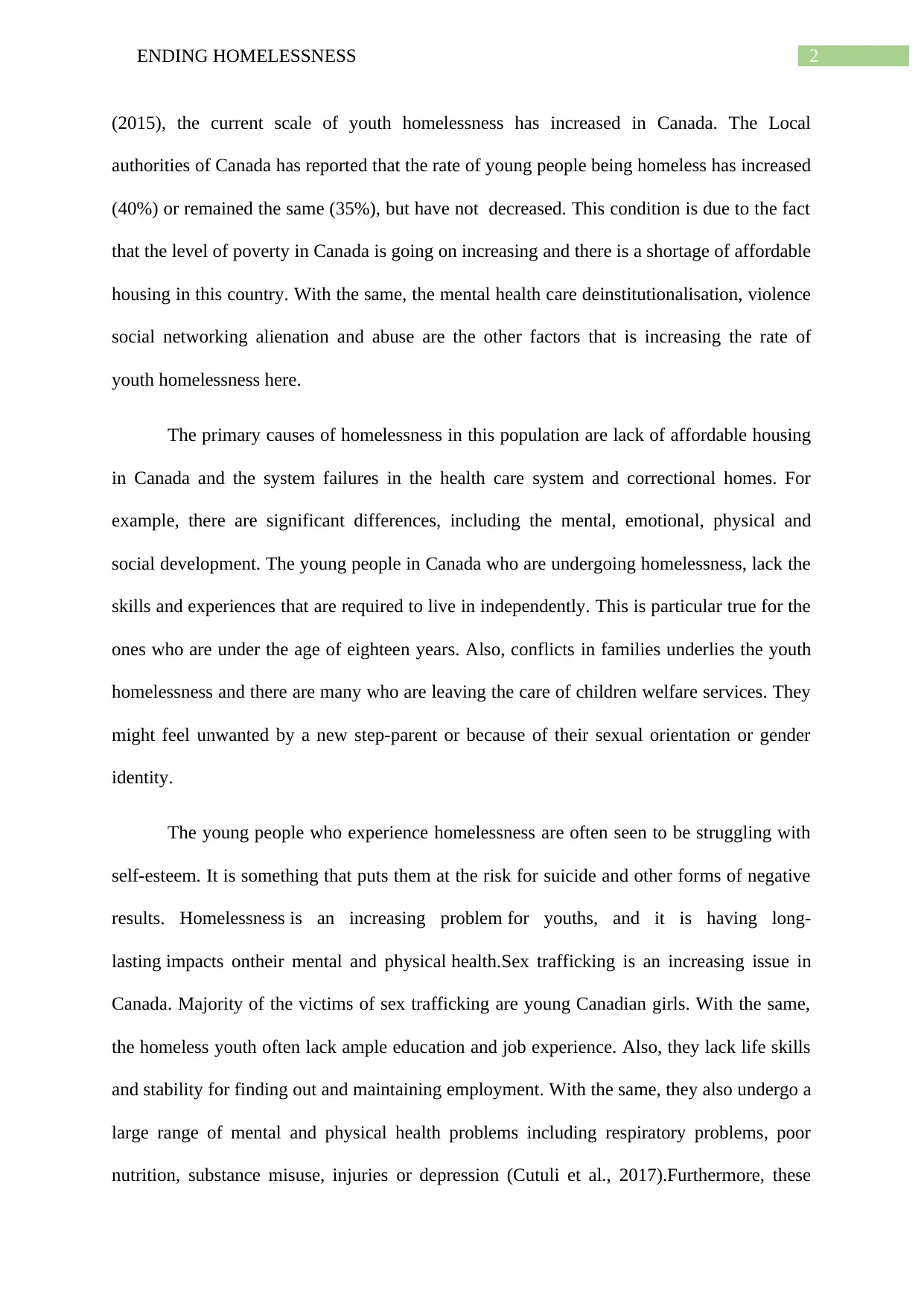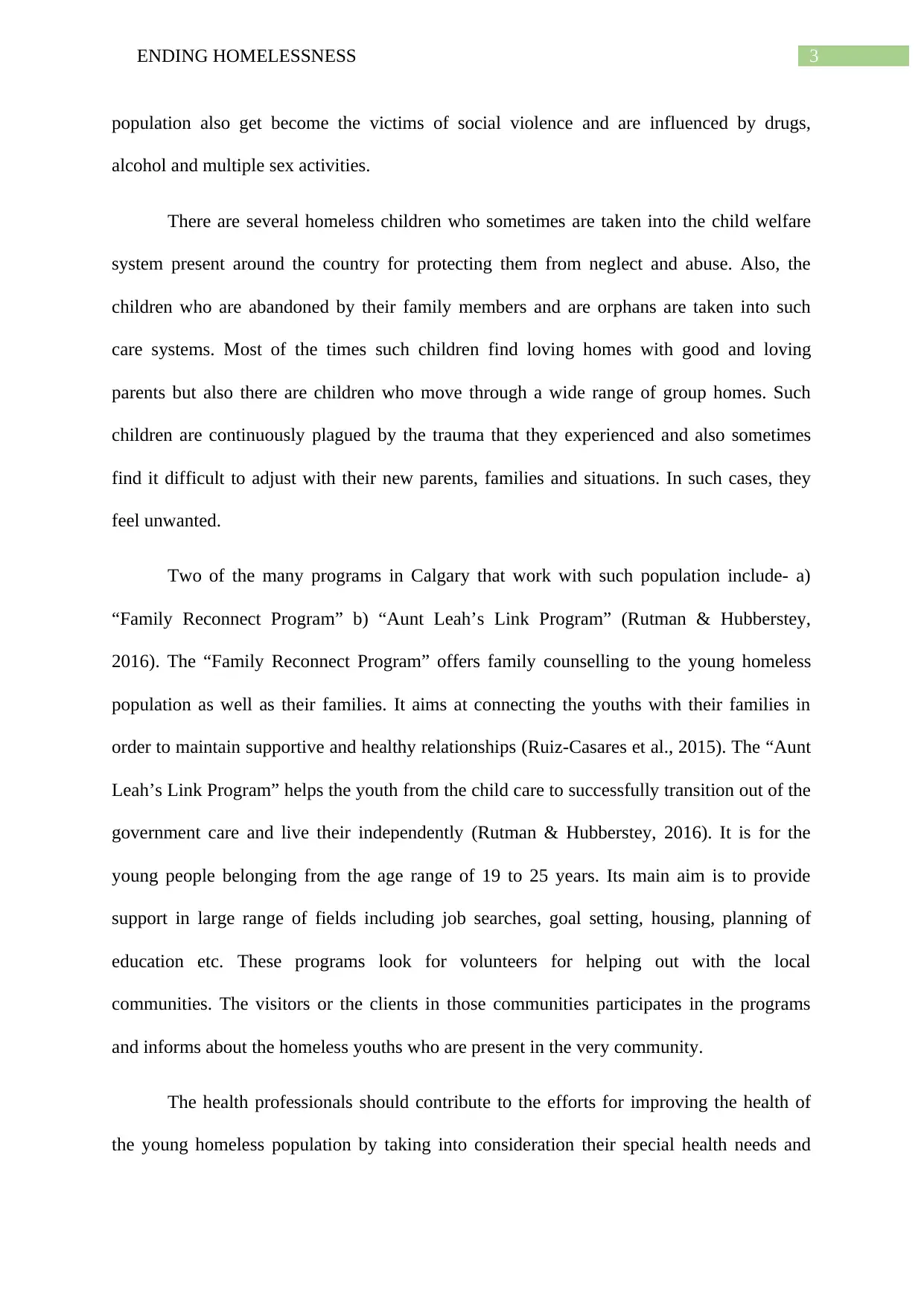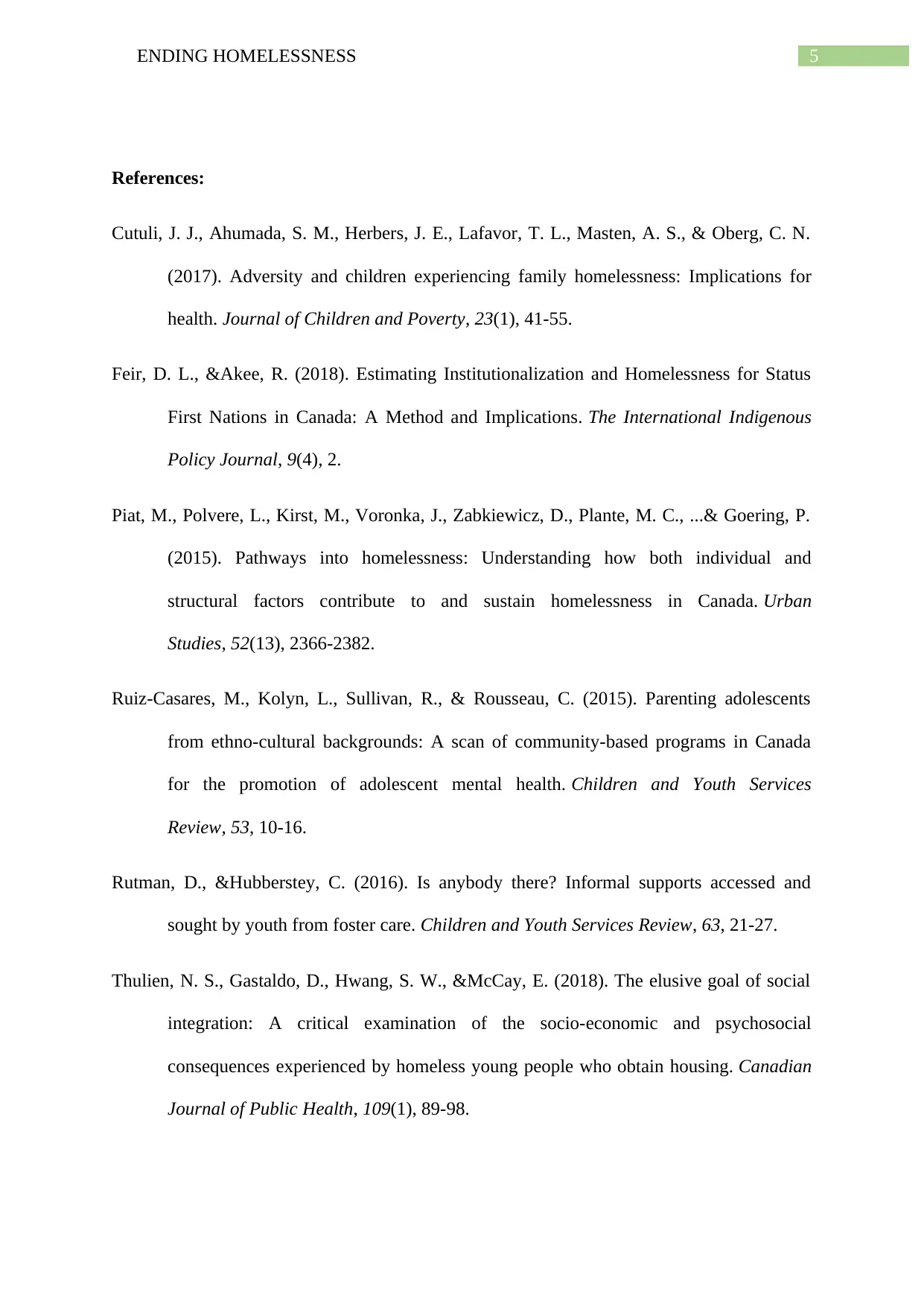Youth Homelessness in Canada: Causes, Impacts, and Potential Solutions
VerifiedAdded on 2021/09/09
|6
|1531
|63
Essay
AI Summary
This essay addresses the critical issue of youth homelessness in Canada, focusing on its definition, prevalence, and the specific challenges faced by this vulnerable population. It explores the primary causes, including lack of affordable housing, failures in healthcare and correctional systems, and family conflicts. The essay highlights the unique health and social issues impacting homeless youth, such as mental health problems, substance misuse, and vulnerability to violence and exploitation. It examines the influence of societal systems, including child welfare and health justice, and describes two programs in Calgary, the Family Reconnect Program and Aunt Leah's Link Program, that offer support. The essay concludes by proposing potential solutions to combat youth homelessness, emphasizing the need for strengthened family support and addressing the unique needs of this population.

Running head: ENDING HOMELESSNESS
Ending Homelessness
Name of the Student:
Name of the University:
Author note:
Ending Homelessness
Name of the Student:
Name of the University:
Author note:
Paraphrase This Document
Need a fresh take? Get an instant paraphrase of this document with our AI Paraphraser

1ENDING HOMELESSNESS
Homelessness is such a problem that virtually every other society suffers from.
Although the world has become much advanced and many job opportunities are there for the
common public all around the globe, still, the existence of homeless people in this society is
evident today. There are several reasons for which people become homeless such as
unemployment, relationship issues, being cheated on or evicted from ones domicile by his or
her friend, family, landlord etc. However, with every cause, there is its effect as well. The
chosen homeless population for this essay is that of the youth homelessness. It shall elaborate
on describing this homeless population including the size of the population and recent trends
in the population. It shall further focus on the unique causes of homelessness in this
population and would briefly describe the unique health and social issues that is impacting
this population. Moreover, this paper is also going to shed light on the impacts of societal
systems such as health justice and child welfare on this population, describing two programs
found in Calgary that work to support this population. Lastly, the paper shall provide some
solutions for this issue as well.
Youth homelessness refers to the homelessness of young people in between the age
range of 13 to 24 years. These are the people who live their life independently of their
caregivers and most importantly, such people lack several social supports that are considered
to be important for the transition period from ones childhood to adulthood. Such people do
not possess a consistent house or residence and also don’t have a permanent source of
income. With the same, they also do not have ample access to the supporting networks
present in the society that are important to foster a nurturing and safer transition of theirs into
the responsibilities of adulthood. It is to note that as per Feir and Akee (2018), about 20% of
the total homeless population belonging from Canada comprise of people belonging from the
age range in between 13 and 24. In the year 2014, there were 35,000 to 40,000 young people
who were experiencing homelessness (Thulien et al., 2018). As per the report of Piat et al.
Homelessness is such a problem that virtually every other society suffers from.
Although the world has become much advanced and many job opportunities are there for the
common public all around the globe, still, the existence of homeless people in this society is
evident today. There are several reasons for which people become homeless such as
unemployment, relationship issues, being cheated on or evicted from ones domicile by his or
her friend, family, landlord etc. However, with every cause, there is its effect as well. The
chosen homeless population for this essay is that of the youth homelessness. It shall elaborate
on describing this homeless population including the size of the population and recent trends
in the population. It shall further focus on the unique causes of homelessness in this
population and would briefly describe the unique health and social issues that is impacting
this population. Moreover, this paper is also going to shed light on the impacts of societal
systems such as health justice and child welfare on this population, describing two programs
found in Calgary that work to support this population. Lastly, the paper shall provide some
solutions for this issue as well.
Youth homelessness refers to the homelessness of young people in between the age
range of 13 to 24 years. These are the people who live their life independently of their
caregivers and most importantly, such people lack several social supports that are considered
to be important for the transition period from ones childhood to adulthood. Such people do
not possess a consistent house or residence and also don’t have a permanent source of
income. With the same, they also do not have ample access to the supporting networks
present in the society that are important to foster a nurturing and safer transition of theirs into
the responsibilities of adulthood. It is to note that as per Feir and Akee (2018), about 20% of
the total homeless population belonging from Canada comprise of people belonging from the
age range in between 13 and 24. In the year 2014, there were 35,000 to 40,000 young people
who were experiencing homelessness (Thulien et al., 2018). As per the report of Piat et al.

2ENDING HOMELESSNESS
(2015), the current scale of youth homelessness has increased in Canada. The Local
authorities of Canada has reported that the rate of young people being homeless has increased
(40%) or remained the same (35%), but have not decreased. This condition is due to the fact
that the level of poverty in Canada is going on increasing and there is a shortage of affordable
housing in this country. With the same, the mental health care deinstitutionalisation, violence
social networking alienation and abuse are the other factors that is increasing the rate of
youth homelessness here.
The primary causes of homelessness in this population are lack of affordable housing
in Canada and the system failures in the health care system and correctional homes. For
example, there are significant differences, including the mental, emotional, physical and
social development. The young people in Canada who are undergoing homelessness, lack the
skills and experiences that are required to live in independently. This is particular true for the
ones who are under the age of eighteen years. Also, conflicts in families underlies the youth
homelessness and there are many who are leaving the care of children welfare services. They
might feel unwanted by a new step-parent or because of their sexual orientation or gender
identity.
The young people who experience homelessness are often seen to be struggling with
self-esteem. It is something that puts them at the risk for suicide and other forms of negative
results. Homelessness is an increasing problem for youths, and it is having long-
lasting impacts ontheir mental and physical health.Sex trafficking is an increasing issue in
Canada. Majority of the victims of sex trafficking are young Canadian girls. With the same,
the homeless youth often lack ample education and job experience. Also, they lack life skills
and stability for finding out and maintaining employment. With the same, they also undergo a
large range of mental and physical health problems including respiratory problems, poor
nutrition, substance misuse, injuries or depression (Cutuli et al., 2017).Furthermore, these
(2015), the current scale of youth homelessness has increased in Canada. The Local
authorities of Canada has reported that the rate of young people being homeless has increased
(40%) or remained the same (35%), but have not decreased. This condition is due to the fact
that the level of poverty in Canada is going on increasing and there is a shortage of affordable
housing in this country. With the same, the mental health care deinstitutionalisation, violence
social networking alienation and abuse are the other factors that is increasing the rate of
youth homelessness here.
The primary causes of homelessness in this population are lack of affordable housing
in Canada and the system failures in the health care system and correctional homes. For
example, there are significant differences, including the mental, emotional, physical and
social development. The young people in Canada who are undergoing homelessness, lack the
skills and experiences that are required to live in independently. This is particular true for the
ones who are under the age of eighteen years. Also, conflicts in families underlies the youth
homelessness and there are many who are leaving the care of children welfare services. They
might feel unwanted by a new step-parent or because of their sexual orientation or gender
identity.
The young people who experience homelessness are often seen to be struggling with
self-esteem. It is something that puts them at the risk for suicide and other forms of negative
results. Homelessness is an increasing problem for youths, and it is having long-
lasting impacts ontheir mental and physical health.Sex trafficking is an increasing issue in
Canada. Majority of the victims of sex trafficking are young Canadian girls. With the same,
the homeless youth often lack ample education and job experience. Also, they lack life skills
and stability for finding out and maintaining employment. With the same, they also undergo a
large range of mental and physical health problems including respiratory problems, poor
nutrition, substance misuse, injuries or depression (Cutuli et al., 2017).Furthermore, these
⊘ This is a preview!⊘
Do you want full access?
Subscribe today to unlock all pages.

Trusted by 1+ million students worldwide

3ENDING HOMELESSNESS
population also get become the victims of social violence and are influenced by drugs,
alcohol and multiple sex activities.
There are several homeless children who sometimes are taken into the child welfare
system present around the country for protecting them from neglect and abuse. Also, the
children who are abandoned by their family members and are orphans are taken into such
care systems. Most of the times such children find loving homes with good and loving
parents but also there are children who move through a wide range of group homes. Such
children are continuously plagued by the trauma that they experienced and also sometimes
find it difficult to adjust with their new parents, families and situations. In such cases, they
feel unwanted.
Two of the many programs in Calgary that work with such population include- a)
“Family Reconnect Program” b) “Aunt Leah’s Link Program” (Rutman & Hubberstey,
2016). The “Family Reconnect Program” offers family counselling to the young homeless
population as well as their families. It aims at connecting the youths with their families in
order to maintain supportive and healthy relationships (Ruiz-Casares et al., 2015). The “Aunt
Leah’s Link Program” helps the youth from the child care to successfully transition out of the
government care and live their independently (Rutman & Hubberstey, 2016). It is for the
young people belonging from the age range of 19 to 25 years. Its main aim is to provide
support in large range of fields including job searches, goal setting, housing, planning of
education etc. These programs look for volunteers for helping out with the local
communities. The visitors or the clients in those communities participates in the programs
and informs about the homeless youths who are present in the very community.
The health professionals should contribute to the efforts for improving the health of
the young homeless population by taking into consideration their special health needs and
population also get become the victims of social violence and are influenced by drugs,
alcohol and multiple sex activities.
There are several homeless children who sometimes are taken into the child welfare
system present around the country for protecting them from neglect and abuse. Also, the
children who are abandoned by their family members and are orphans are taken into such
care systems. Most of the times such children find loving homes with good and loving
parents but also there are children who move through a wide range of group homes. Such
children are continuously plagued by the trauma that they experienced and also sometimes
find it difficult to adjust with their new parents, families and situations. In such cases, they
feel unwanted.
Two of the many programs in Calgary that work with such population include- a)
“Family Reconnect Program” b) “Aunt Leah’s Link Program” (Rutman & Hubberstey,
2016). The “Family Reconnect Program” offers family counselling to the young homeless
population as well as their families. It aims at connecting the youths with their families in
order to maintain supportive and healthy relationships (Ruiz-Casares et al., 2015). The “Aunt
Leah’s Link Program” helps the youth from the child care to successfully transition out of the
government care and live their independently (Rutman & Hubberstey, 2016). It is for the
young people belonging from the age range of 19 to 25 years. Its main aim is to provide
support in large range of fields including job searches, goal setting, housing, planning of
education etc. These programs look for volunteers for helping out with the local
communities. The visitors or the clients in those communities participates in the programs
and informs about the homeless youths who are present in the very community.
The health professionals should contribute to the efforts for improving the health of
the young homeless population by taking into consideration their special health needs and
Paraphrase This Document
Need a fresh take? Get an instant paraphrase of this document with our AI Paraphraser

4ENDING HOMELESSNESS
working towards meeting those needs. Furthermore, for helping youth experiencing
homelessness make supportive transitions to adulthood for avoiding life living in the street, is
strengthening their families and addressing their needs. One of the potential barrier to this
would be the non-cooperation of the youth and their families.
working towards meeting those needs. Furthermore, for helping youth experiencing
homelessness make supportive transitions to adulthood for avoiding life living in the street, is
strengthening their families and addressing their needs. One of the potential barrier to this
would be the non-cooperation of the youth and their families.

5ENDING HOMELESSNESS
References:
Cutuli, J. J., Ahumada, S. M., Herbers, J. E., Lafavor, T. L., Masten, A. S., & Oberg, C. N.
(2017). Adversity and children experiencing family homelessness: Implications for
health. Journal of Children and Poverty, 23(1), 41-55.
Feir, D. L., &Akee, R. (2018). Estimating Institutionalization and Homelessness for Status
First Nations in Canada: A Method and Implications. The International Indigenous
Policy Journal, 9(4), 2.
Piat, M., Polvere, L., Kirst, M., Voronka, J., Zabkiewicz, D., Plante, M. C., ...& Goering, P.
(2015). Pathways into homelessness: Understanding how both individual and
structural factors contribute to and sustain homelessness in Canada. Urban
Studies, 52(13), 2366-2382.
Ruiz-Casares, M., Kolyn, L., Sullivan, R., & Rousseau, C. (2015). Parenting adolescents
from ethno-cultural backgrounds: A scan of community-based programs in Canada
for the promotion of adolescent mental health. Children and Youth Services
Review, 53, 10-16.
Rutman, D., &Hubberstey, C. (2016). Is anybody there? Informal supports accessed and
sought by youth from foster care. Children and Youth Services Review, 63, 21-27.
Thulien, N. S., Gastaldo, D., Hwang, S. W., &McCay, E. (2018). The elusive goal of social
integration: A critical examination of the socio-economic and psychosocial
consequences experienced by homeless young people who obtain housing. Canadian
Journal of Public Health, 109(1), 89-98.
References:
Cutuli, J. J., Ahumada, S. M., Herbers, J. E., Lafavor, T. L., Masten, A. S., & Oberg, C. N.
(2017). Adversity and children experiencing family homelessness: Implications for
health. Journal of Children and Poverty, 23(1), 41-55.
Feir, D. L., &Akee, R. (2018). Estimating Institutionalization and Homelessness for Status
First Nations in Canada: A Method and Implications. The International Indigenous
Policy Journal, 9(4), 2.
Piat, M., Polvere, L., Kirst, M., Voronka, J., Zabkiewicz, D., Plante, M. C., ...& Goering, P.
(2015). Pathways into homelessness: Understanding how both individual and
structural factors contribute to and sustain homelessness in Canada. Urban
Studies, 52(13), 2366-2382.
Ruiz-Casares, M., Kolyn, L., Sullivan, R., & Rousseau, C. (2015). Parenting adolescents
from ethno-cultural backgrounds: A scan of community-based programs in Canada
for the promotion of adolescent mental health. Children and Youth Services
Review, 53, 10-16.
Rutman, D., &Hubberstey, C. (2016). Is anybody there? Informal supports accessed and
sought by youth from foster care. Children and Youth Services Review, 63, 21-27.
Thulien, N. S., Gastaldo, D., Hwang, S. W., &McCay, E. (2018). The elusive goal of social
integration: A critical examination of the socio-economic and psychosocial
consequences experienced by homeless young people who obtain housing. Canadian
Journal of Public Health, 109(1), 89-98.
⊘ This is a preview!⊘
Do you want full access?
Subscribe today to unlock all pages.

Trusted by 1+ million students worldwide
1 out of 6
Related Documents
Your All-in-One AI-Powered Toolkit for Academic Success.
+13062052269
info@desklib.com
Available 24*7 on WhatsApp / Email
![[object Object]](/_next/static/media/star-bottom.7253800d.svg)
Unlock your academic potential
Copyright © 2020–2025 A2Z Services. All Rights Reserved. Developed and managed by ZUCOL.



